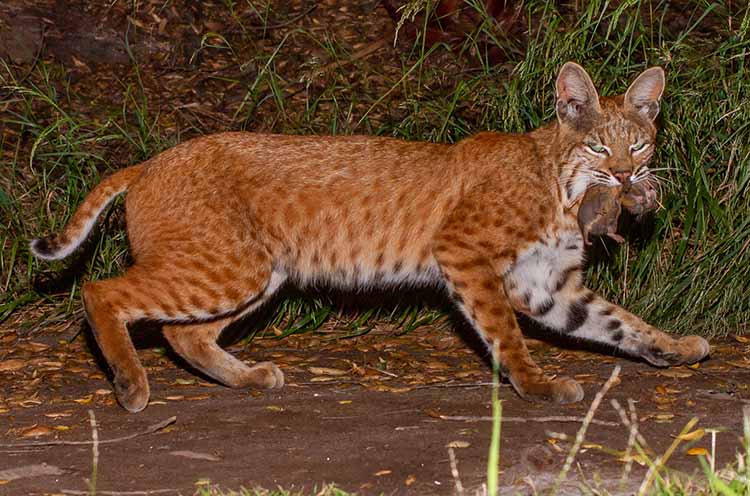Bobcat
Control and How to Prevent Attacks
A bobcat - a consummate predator and a bold raider - can become a nuisance that has to be controlled. Its screams in the night can frighten youngsters. If rabid, it can pose a serious threat to humans. Deprived of natural prey, it may turn to livestock and pets for food.
Minimize Encounters
Should you encounter a bobcat, you should keep as much distance between you and the animal as possible:
- Immediately protect children and pets
- Back away from the bobcat slowly and deliberately
- Avoid running away because that could trigger a pursuit response
- If possible, spray the animal with water
- When possible make a lot of noise (banging pans, for instance, or blowing
an air horn)
Attacks
Attacks by bobcats on humans are rare. Normally if a bobcat approaches a human or seems aggressive towards you it is most likely sick or rabid. If a bobcat tries to attack you do whatever you can to defend yourself. If attacked, seek medical care promptly. If the bobcat is killed during the attack, make sure you have authorities examine the carcass of the bobcat for rabies or other diseases.
If you see a bobcat hanging around a populated neighborhood or where people frequently hang out, notify animal control authorities immediately. They can observe the bobcat and remove it from the area if it seems to be a threat.

Protect Livestock
A bobcat that preys persistently on free-ranging livestock may require relocation or extermination, probably by a government agency or a commercial trapper. Contact your local Department of Fish and Game for assistance with removing bobcats or other predators from your area.
A bobcat might also be discouraged from attacking livestock by a fence, if practicable. The Los Angeles Animal Services, on its Internet site, suggests that the fence should be at least 6 feet high, with the bottom extended some 6 to 12 inches below ground and the top protected by an outward-facing 16-inch wide-angle extension. (Without the wide-angle extension, the bobcat could likely jump the fence.)
Video
Protect Your Yard
If bobcats begin to appear in your neighborhood, you can take several precautions to discourage visits and protect pets:
- Trim back excess vegetation that might otherwise provide cover
- Do not feed birds or other wildlife, which might attract bobcats
- Do not feed the bobcats
- Do not leave pet food or water outdoors
- Vaccinate your pets
- Keep pets indoors or in secure, protective cages or pens
- Consider a deterrent that generates electronic sounds that mimic the calls of bobcats' enemies, for instance, the hiss of a cougar
Common Questions About Bobcats
Do bobcats attack people?
How can I protect my dog or cat from bobcat attacks?
What do bobcats look like?
If you can discourage bobcat visits and predation, you could not only increase the security for you and your family as well as for livestock pets, you could very well save a bobcat's life.
by Jay W. Sharp
The information provided on this web site and by this web site through content provided by Authors or third party providers, and in other sources to which it refers, is PROVIDED FOR INFORMATIONAL PURPOSES ONLY and should not be used to diagnose or treat a health problem or disease.
Information provided at and by DesertUSA is NOT A SUBSTITUTE FOR PROFESSIONAL MEDICAL CARE. If you have a medical concern, or suspect you have a health problem you should consult your primary doctor or specialist.
If you cannot agree to this Health and Medical Disclaimer, you are not permitted to use this web site and should exit immediately.
Share this page on Facebook:
The Desert Environment
The North American Deserts
Desert Geological Terms







